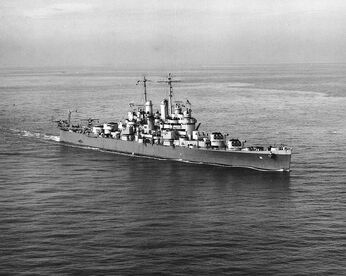| Afilliation | United States Navy |
|---|---|
| Max. Displacement | 14131 |
| Main Guns | 4 turrets (2 forward, 2 aft) |
| Sub Guns | 6 slots |
| Torpedoes | N/A |
| Anti Sub | 1 slot in place of front sub-gun |
| Has Camouflage | No |
| Cost | 152000 |
| REXP | 5000 |
| Required Level | 18 |
| Upgraded From | Atlanta-class |
| Upgrades Into | Baltimore-class |
The U.S. Navy designed the Cleveland class of light cruisersfor World War II with the goal of increased cruising range, anti-aircraft armament, torpedo protection, etc., compared with earlier U.S. cruisers.[1]
52 light cruisers of this class were originally planned, but nine of them were completed as the light aircraft carriers of theIndependence class, and two of them were completed to a somewhat different design, with more compact superstructures and just a single stack. These two were called the Fargo class. Of the 27 Cleveland-class cruisers that were commissioned, one (Galveston) was completed as a guided missile cruiserand five were later modified as Galveston and Providence-class guided missile cruisers. Following the naming convention at the time, all the ships completed as cruisers were named for US cities and towns.[2]
Technical drawing of a Cleveland-class cruiser.
The Cleveland-class cruisers served mainly in the Pacific Fleetduring World War II, especially in the Fast Carrier Task Force, but some of them served off the coasts of Europe and Africa in the U.S. Atlantic Fleet. All of these warships, though hard worked in both the Atlantic and Pacific fleets, and in some cases heavily damaged in combat, survived the war. Except for Manchester, which remained in service until 1956, and the guided missile cruisers all of these cruisers were decommissioned by 1950. They suffered from increasing stability problems as anti-aircraft armament and additional radar was added during the war. None were recommissioned for the Korean War, as they required a crew almost as large as the Baltimore-class ships, and those ships were reactivated instead. All non-converted ships were sold off from the reserve fleet for scrapping beginning in 1959. The six that were completed as or converted into guided missile cruisers were reactivated during the 1950s and then served into the 1970s. All particularly the Talos armed ships suffered from greater stability problems, than the original design, due to the extra radar and equipment and top weight, which was particularly severe in Galveston, leading to its premature decommissioning in 1970 and Oklahoma City and Little Rockhad to have a large amount of ballast and internal rearrangement to allow continued service in the 1970s.[3] The last of these in service, Oklahoma City, was decommissioned in December 1979.
Only one Cleveland-class cruiser remains in existence. She is the guided missile cruiser Little Rock, which is a museum shipalong the Niagara River at Buffalo, New York, along with theFletcher-class destroyer The Sullivans, and the Gato-classsubmarine, Croaker.[4]
